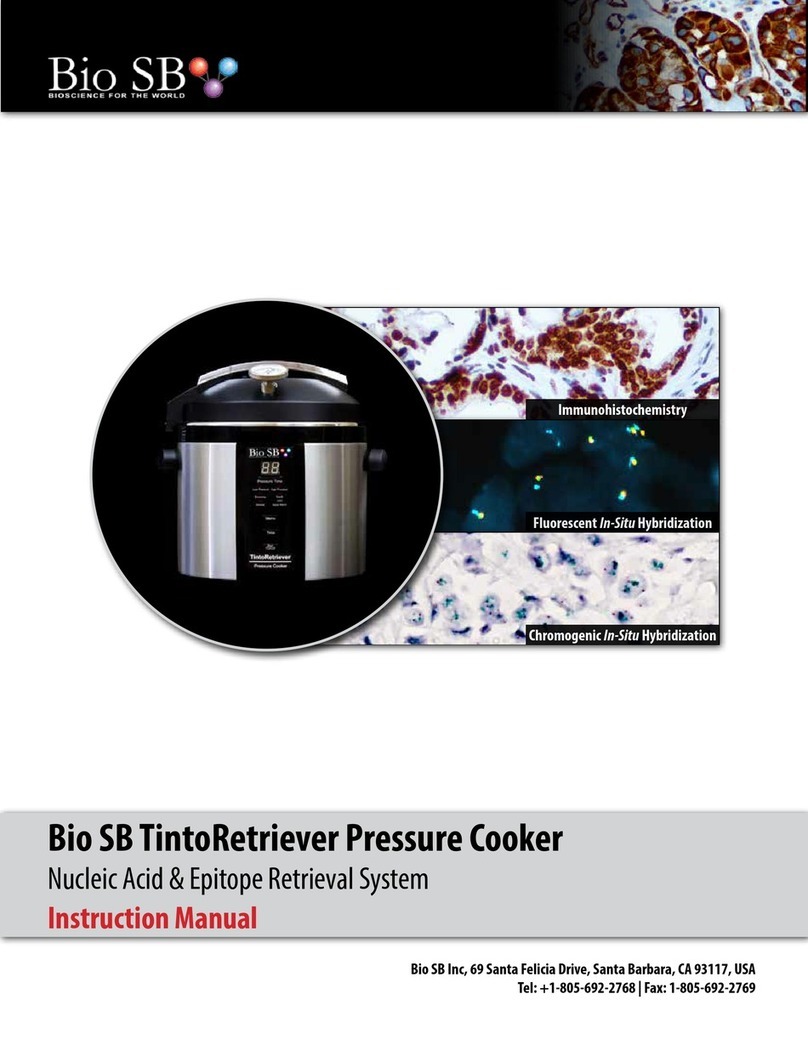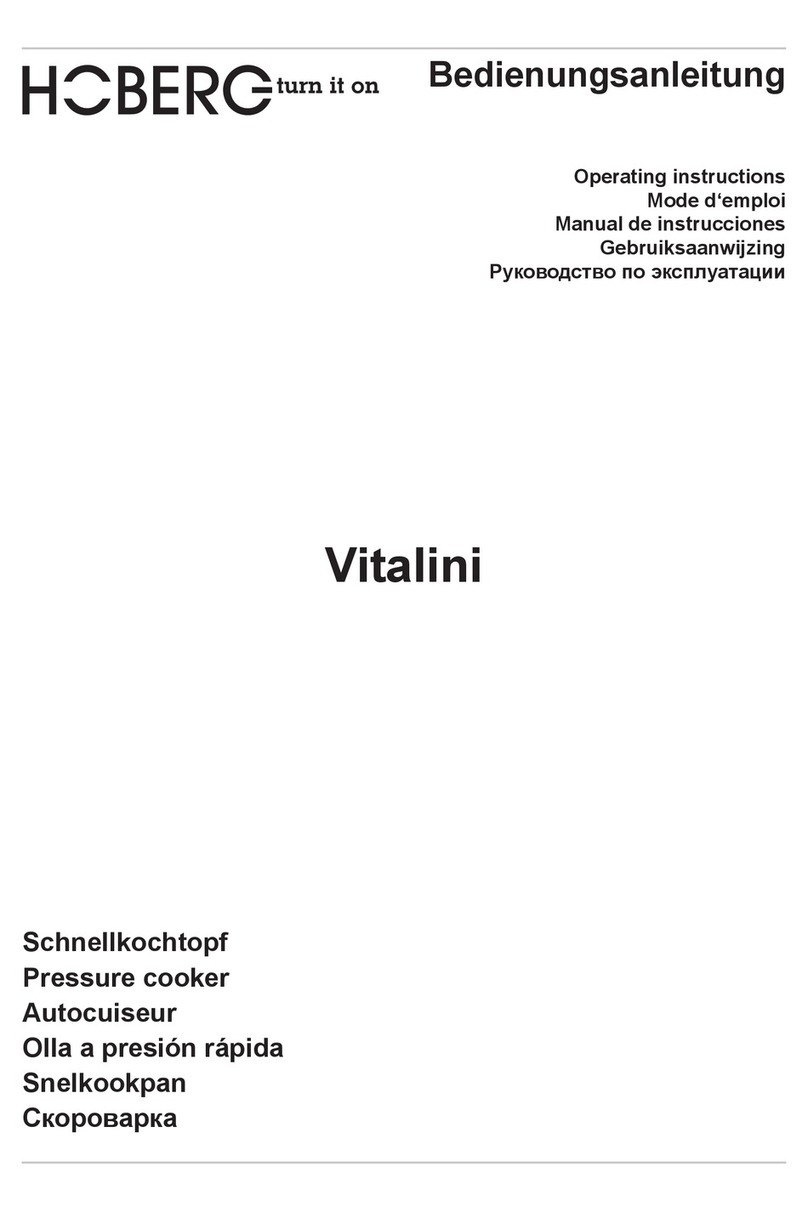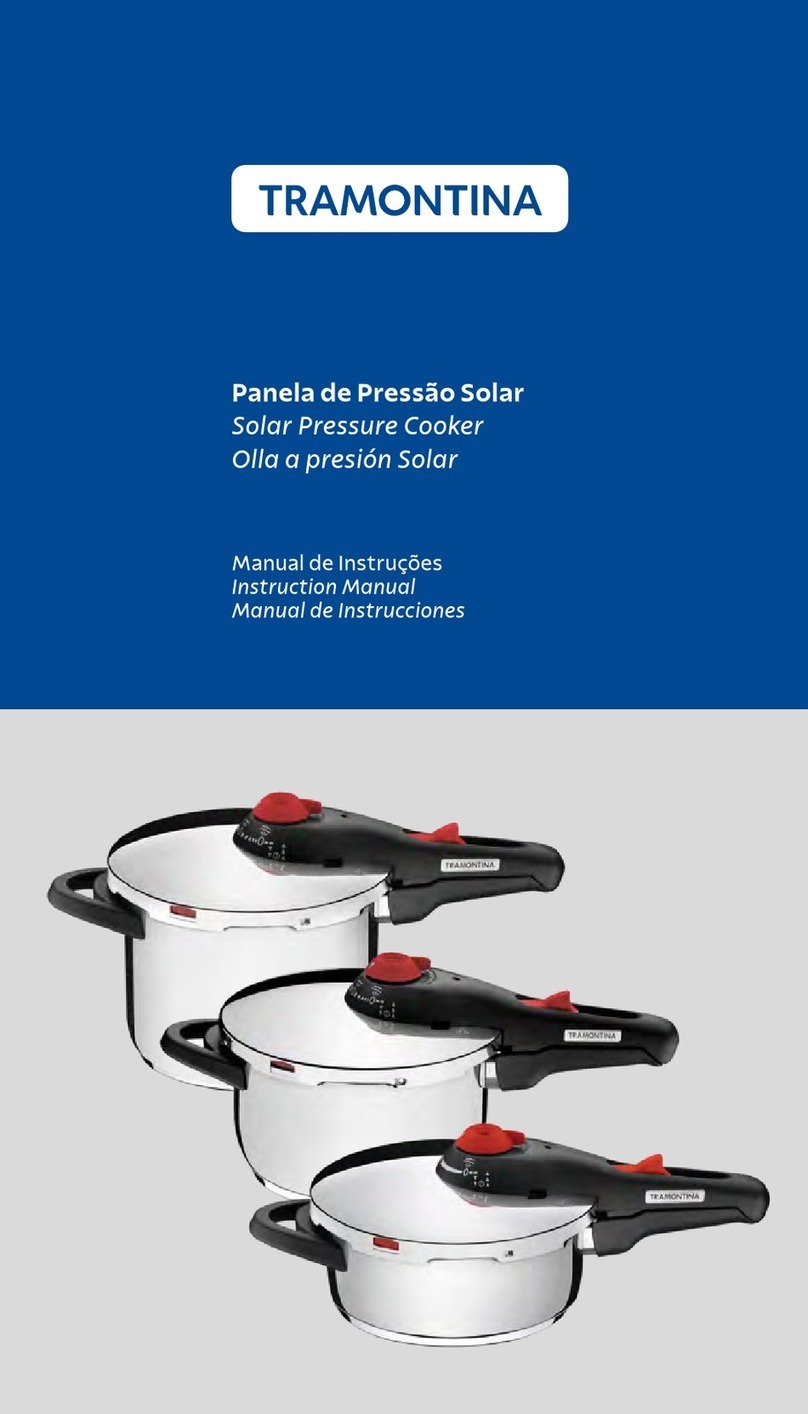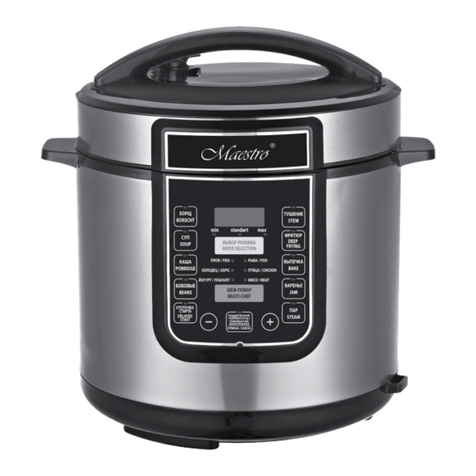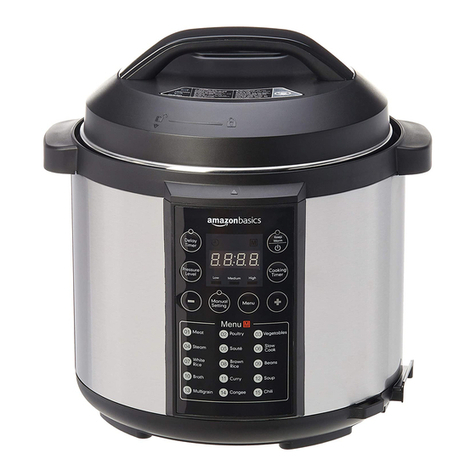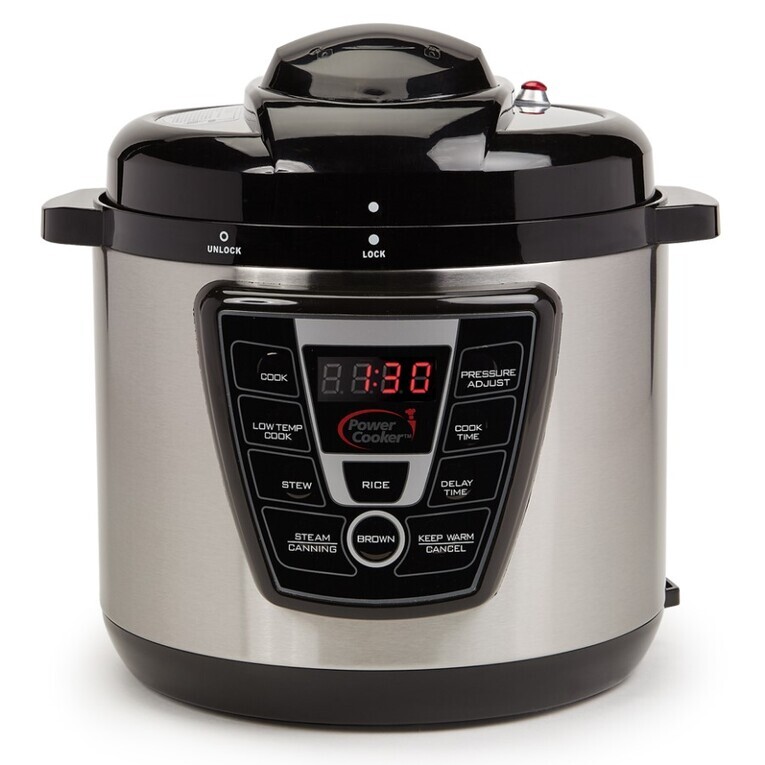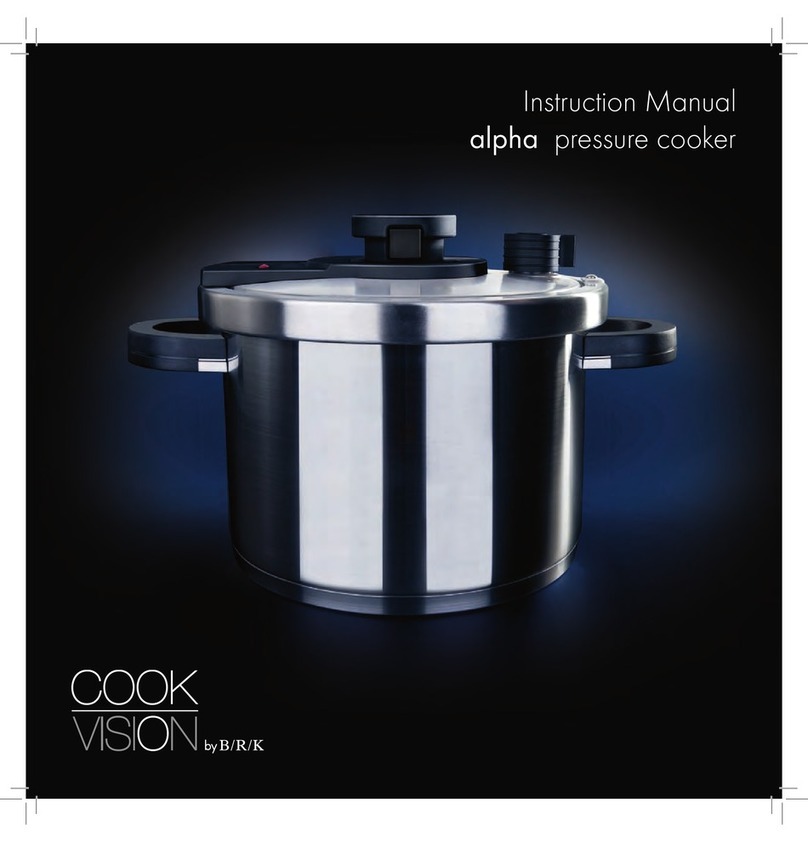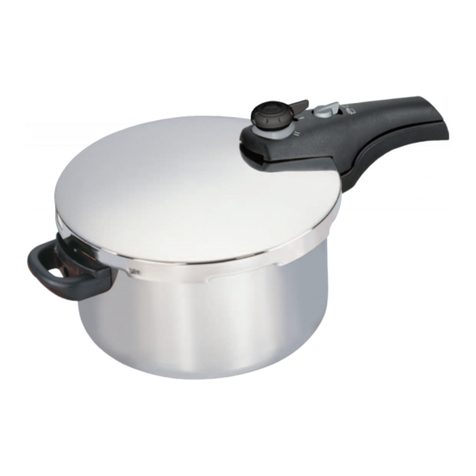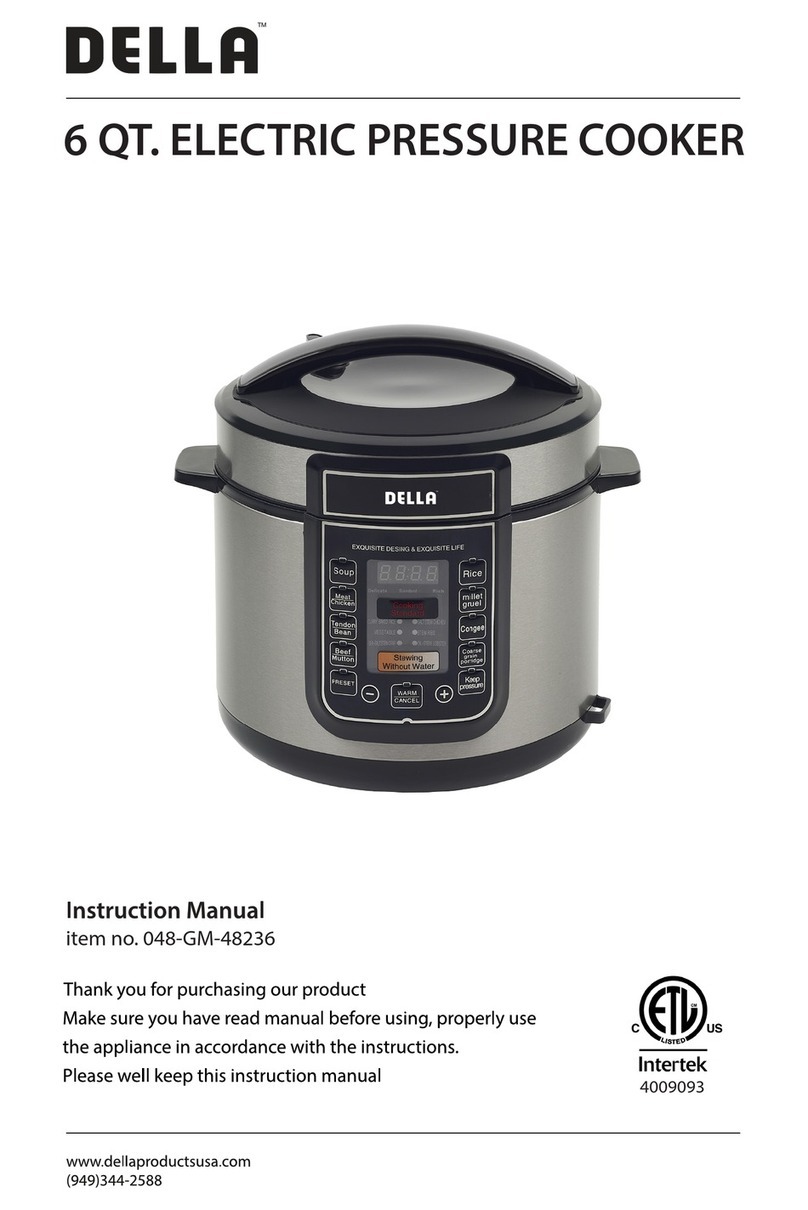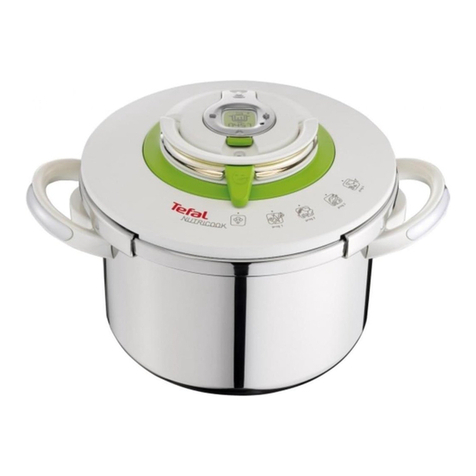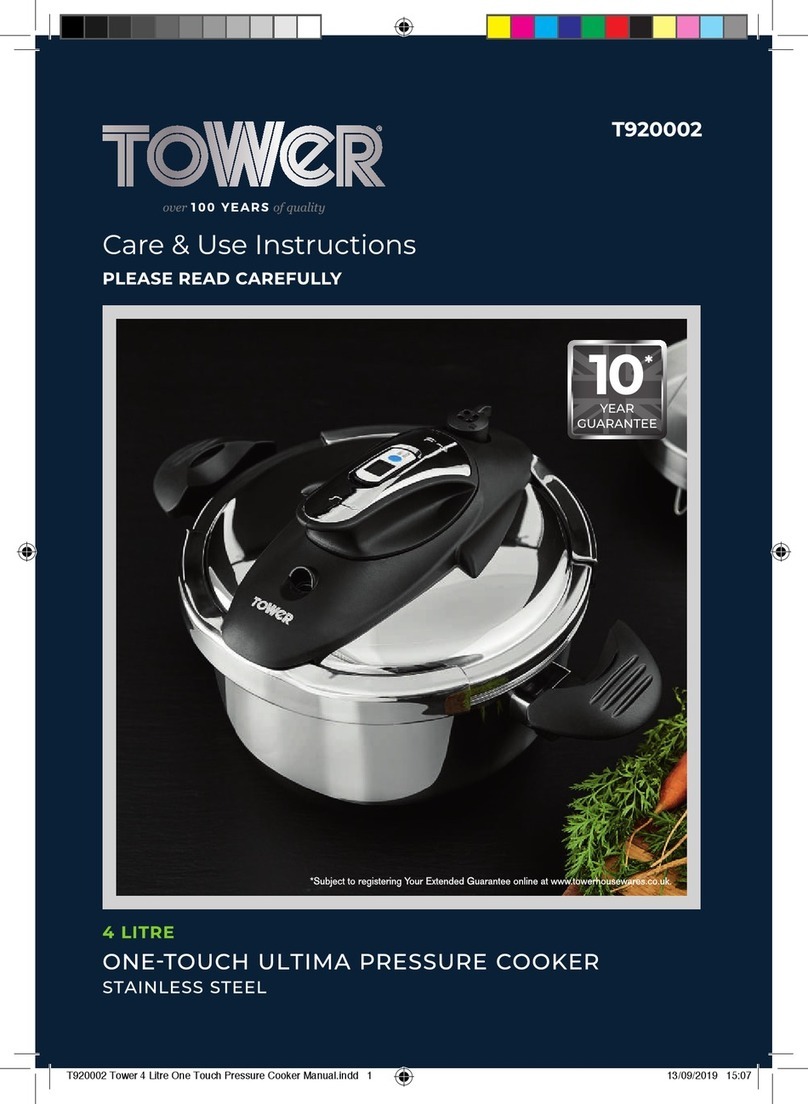Bio SB TintoRetriever User manual

TROUBLESHOOTING:
TECHNICAL FEATURES:
To contact Bio SB Technical Support
Phone: 1-800-561-1145
Email: Technical@biosb.com
INSTRUCTION MANUAL
TINTORETRIEVER PRESSURE COOKER
For Epitope & Nucleic Acid Retrieval
Bio SB Inc.
5385 Hollister Ave., Building 8, #108, Santa Barbara, CA 93111, USA
Tel (USA): 1-800-561-1145 | Tel (Int): +1-805-692-2768 | Fax: 805-692-2769
Immunohistochemistry
Immunocytochemistry
Immunouorescence
Fluorescent In-Situ Hybridization
Chromogenic In-Situ Hybridization

www.biosb.com | 1-805-692-2768 | [email protected] www.biosb.com | 1-805-692-2768 | [email protected]
1 2
Sealing Ring
Aluminum Lid
Install
Disassembly
Top Cover
Power
1
4
5
9
10
11
13
14
12
6
7
8
2
3
1. Release Valve
2. Lid Handle
3. Pressure Cooker Lid
4. Pressure Cooker
Chamber
5. Upper Ring
6. Housing
7. Heating Plate
8. Unit Base
9. Control Panel
10. Sealing Ring
11. Sealing Ring Support
12. Supporting Cap for
the Sealing Ring
13.
14. Float Valve
TintoRetriever Pressure Cooker Applications
Condensation Collector
TINTORETRIEVER COMPONENTS:
Sealing Ring Installation
DESCRIPTION & FEATURES:
15
15. Analog Thermometer
Cord
Tissues xed with formalin (or other additive xatives) and embedded in paran, require an epitope or
nucleic acid retrieval step prior to any immunochemical staining.The epitope or nucleic acid retrieval step
breaks some of the methylene bridges that cross-link proteins or nucleic acids in formalin-xed tissues and
allows antibodies, probes or other immunochemicals to bind to unmasked epitopes or nucleic acids.
Heat-induced epitope retrieval (HIER) and nucleic acid retrieval steps are most often performed using
a conventional pressure cooker, water baths, steamers or a microwave oven. The Bio SB TintoRetriever
is a precision-controlled heat source capable of maintaining a constant and reliable temperature while
minimizing the potential for evaporation of the working solution under HIER procedure conditions.
TheTintoRetriever Pressure cooker is recommended for use in Immunohistochemistry (IHC),
Immunocytochemistry (ICC), Immunouorescence (IF) and In-Situ Hybridization (ISH)) protocols, and can
be easily integrated into a clinical or research laboratory.
• Rapid Heat Retrieval
• Multiple Temperature Settings
• Use in IHC, ICC, IF and ISH Applications
• Low Solution Use
• Holds 96 Slides Per Run
• Cost Eective HIER Solution
IHC
p40 RMab
FISH
ALK/EML4
TriCheck
CISH
HER2/CEN 17
ICC
Ki-67 RMab
IF
IgA FITC

Pressure
Release
INSTALLATION: OPERATION PROCEDURES:
Pressure Cooker Valve Positions
Pressure
Pressure
Release
Pressure Cooker Valve Positions
Pressure
1. Open the pressure cooker lid by rotating it clockwise until it stops, and then lift the pressure cooker lid.
2. Before using, clean the pressure cooker chamber with a moist cloth or paper towel and wipe the heating
plate to ensure that they are clean. Slightly rotate the pressure cooker chamber to make sure it ts the
heating plate.
3. Close the lid.
• Ensure that the sealing gasket on the pressure cooker is not damaged.
• Place the lid on the pressure cooker, and turn the handle counter clockwise until the lid is closed.
4. Tear o the silver label attached to the pressure release valve to ensure that the valve is able to move
freely.
5. As shown in the gure below, attach the condensation collector to the pressure cooker.
6. When turned on, the pressure cooker will make a beeping sound, the LCD display will light up and the
pressure cooker will enter standby mode.
1. Add approximately 500 to 1000 mL of DI water to the pressure cooker chamber, so that the water
slightly touches the staining dishes.
2. Position the Staining Dish Support inside the pressure cooker chamber.
3. Place slide racks with the slides in the Staining Dishes. Gently ll the Staining Dish with a working con-
centration of the HIER solution. We recommend Bio SB ImmunoDNA Retriever Citrate (BSB 0020 - BSB
0023) or the Bio SB ImmunoDNA Retriever EDTA (BSB 0030 - BSB 0033) or equivalents.
4. Position the Staining Dishes with slides into the Staining Dish Support.
5. Place and secure the lid onto the cooker’s main body. Turn the lid counter clockwise to secure it into
place.
6. Position the pressure limit valve to the “pressure”position.
7.Select and press the preset temperature button on the control panel.
8. Press theTime button on the control panel and use the plus (+) and minus (-) buttons to select the
desired time, which will be indicated on the display.
9. Press Start to begin the pressure cooker cycle.
10. The timer will start counting down only after the unit reaches the preset temperature and pressure.
After the pressure cooking cycle
1. At the end of the cycle, the pressure cooker beeps once before the heating plate turns o.
NOTE: After the heating cycle, do not keep slides in the pressure cooker for an extended
amount of time, as the temperature inside the chamber decreases slowly and this may
aect the performance of your nucleic acid or epitope retrieval procedure.
2. Slowly rotate the pressure valve to the“Pressure Release”position in order to discharge steam and make
sure that the oat valve drops. Leave the valve in the“Pressure Release”position until there is no steam
in the pressure cooker chamber.
Cancel
1. When pressure cooker is working or during a set function, press this key to cancel all current settings,
and set the instrument in standby mode.

TINTORETRIEVER IN THE LABORATORY:
CLEANING AND STORAGE:
SAFETY PRECAUTIONS:
1. Before cleaning, unplug the unit from the outlet.
2. Wait until the working chamber, the water inside chamber and the support have cooled to room
temperature, then discard the water from the chamber.
3. Use a clean cloth or paper towels to clean the lid, including gasket, pressure release valve, lter, vent
hole, oat valve and pressure cooker chamber.
4. Use a soft cloth or paper towels to wipe the outside of the pressure cooker. Do not immerse the pressure
cooker in water to wash it!
5. Empty the water in the inner pressure chamber. Use water and a soft brush or non-metallic brush to
clean the inner pressure chamber, then wipe and dry with a cloth or paper towels. Never use detergents,
harsh chemicals or scouring pads.
6. Use a soft brush to clean the discharge pressure valve and vent hole to ensure that steam can pass
through the valve.
7. Disconnect the condensation collector, remove any water, and dry it with cloth or paper towel.
8. Reconnect the condensation collector to the main body and place the inner pressure chamber back inside
the main body. Place the support inside the pressure chamber cooker and place the lid on top of the
main body. Protect from heat, moisture, mechanical and electromagnetic shock. After use, do not lock
the lid to allow any residual moisture to escape the internal parts of cooker.
TheTintoRetriever Pressure Cooker is a rapid epitope and nucleic acid retrieval system which can be used
in a variety of applications in the modern Pathology Lab.This section will focus on tips and recommended
settings for the TintoRetriever in a Clinical or Research setting.
Dierent Temperature Options
The Bio SBTintoRetriever Pressure Cooker comes preprogrammed
with 6 temperature settings (60°C, 80°C, 90°C, 100°C, 110°C and
115°C) that can be used for deparanization, heat epitope
retrieval for IHC, ICC and IF or nucleic acid retrieval for CISH and
FISH.
IHC, ICC and IF Epitope Retrieval & ISH Nucleic Acid Retrieval
For formalin xed paran-embedded (FFPE) tissue sections, the higher temperature settings (100°C,
110°C or 115°C) with a time of 10 to15 minutes is recommended for thorough heat permabilization
of tissues.We recommend using Bio SB ImmunoDNA Retriever with Citrate (BSB-0020 – BSB 0023) or
ImmunoDNA Retriever with EDTA (BSB 0030 – BSB0033) for IHC, ICC, IF and ISH protocols.
Tissues Prone to Detachment
Should tissues detach after using the high temperature setting, it is recommended that tissues are
mounted using Bio SB Hydrophilic Plus Slides (BSB 7028). Hydrophilic Plus Slides prevent tissue
detachment while promoting reagent dispersion.
Tissue Microarrays
Tissue Microarrays (orTMA’s) typically need gentler epitope retrieval methods than those used with whole
tissue sections. At Bio SB, our Normal, Cancer and Cell Line Microarrays undergo heat-induced epitope or
nucleic acid retrieval using the low temperature settings (100°C) or higher temperature (110°C or 115°C)
options.
TintoDeparanator Citrate and EDTA
TheTintoDeparanator Citrate (BSB 0175 - BSB 0176) andTintoDeparanator EDTA (BSB 0177 - BSB 0178)
are safe, ecient and economical alternatives to traditional deparanization. These solvent-free products
reduce exposure to toxic solvents like xylenes, toluene and alcohols when handling FFPE tissues for
molecular pathology. These solutions are recommended to be used at lower temperature settings (100°C)
or high temperature settings (110°C or 115°C) for 15 min.
1. Read user manual before performing installation, operation or maintenance on the pressure cooker, to
avoid personal injury and damage to the instrument.
2. Do not immerse electrical cord, plugs or pressure cooker body into water or other liquids to avoid electri-
cal shock and/or re hazard.
3. Do not touch hot surfaces of the pressure cooker. Use handles only.
4. Operate the pressure cooker only with properly closed lid.
5. Never attempt to open the lid while the unit is operating. Wait until the unit is turned o and pressure
has been completely released. If the lid is dicult to rotate, this indicates that the working chamber has
excess pressure.
6. Never move the pressure cooker while operating it.
7. Exercise care when releasing excess pressure from the cooker. Improper technique may result in scalding
or injury. Do not use under hanging shelves, cabinets, etc. or damage may occur.
8. Unplug from outlet when not in use or when cleaning / servicing.
9. Always check the pressure limit valve for possible clogging before each run.
10. If the pressure cooker malfunctions during the warranty period, please contact the Bio SB Technical
Services Department: Technical@biosb.com.
Start
Time
60℃
80℃
90℃
100℃
110℃
115℃
TintoRetriever
Pressure Cooker
Temperature Setting Temperature Range
60°C 51°C - 64°C
80°C 72°C - 84°C
90°C 85°C - 95°C
100°C 95°C - 105°C
110°C 105°C - 115°C
115°C 110°C - 120°C

TROUBLESHOOTING:
TECHNICAL FEATURES:
To contact Bio SB Technical Support
Phone: 1-800-561-1145
Email: Technical@biosb.com
INSTRUCTION MANUAL
TINTORETRIEVER PRESSURE COOKER
For Epitope & Nucleic Acid Retrieval
Bio SB Inc.
5385 Hollister Ave., Building 8, #108, Santa Barbara, CA 93111, USA
Tel (USA): 1-800-561-1145 | Tel (Int): +1-805-692-2768 | Fax: 805-692-2769
Cat. #: BSB-7087 Rated Capacity: 6L of Fluid or 96 Slides
Rated Power: 1000W RatedVoltage: 110-220V 50-60Hz
Working Pressure: 0-60Kpa Limited Pressure: 80Kpa
No. Description Cause Solution
1 Unable to close lid. The installation of the aluminum lid
with gasket is not correct.
Properly position the aluminum lid with gasket
on support.
The oat valve is jammed. Gently poke the oat valve with a paper clip or
tooth pick.
2 Unable to open the
pressure cooker lid.
The oat valve doesn’t fall. Use a paper clip or toothpick to lower the oat
valve.
3 Excess vapor leaking from
pressure cooker lid.
The installation of the sealing gasket
is not correct.
Properly set the sealing gasket on the aluminum
lid.
Sealing gasket has residue. Clean the sealing gasket.
Sealing gasket is damaged. Replace the sealing gasket.
The pressure cooker lid is not properly
closed.
Cover the lid according to the manual.
4 Air leaks from the oat
valve.
The gasket of the oat valve has
residue or particles.
Clean the gasket of the oat valve.
The gasket of the oat valve is
damaged.
Replace the gasket of the oat valve.
5 The oat valve is not rising. Internal pressure doesn’t reach the
minimum limit.
ContactTechnical Support for assistance.
Air leakage of the pressure cooker lid or
the discharge pressure valve.
ContactTechnical Support for assistance.
6 E1 Open circuit of the sensor. ContactTechnical Support for assistance.
7 E2 Short circuit of the sensor. ContactTechnical Support for assistance.
8 E3 Overheating. ContactTechnical Support for assistance.
9 E4 Pressure Switch Failure. ContactTechnical Support for assistance.
Other manuals for TintoRetriever
1
Table of contents
Other Bio SB Electric Pressure Cooker manuals
